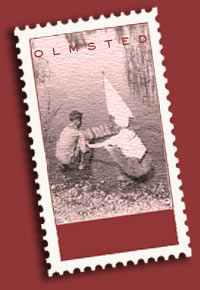
The Olmsted Legacy
Just over one hundred years ago, the city of Spokane owned less than 200 acres of land for public parks. This small area provided insufficient public space for the rapidly increasing population of the city, and civic leaders agreed to take swift action to prevent Spokane from becoming a victim of industrialization.
The initiative to establish a park system in Spokane was part of a national campaign called the City Beautiful Movement, which developed as a response to rapid nineteenth century industrialization that had turned America's natural landscapes into unsightly urban work places. The movement was supported in Spokane by advocacy groups like the City Beautiful Committee and the 150,000 Club, and was politically driven by the establishment of the non-partisan Parks Commission in 1907. The commission was headed by Aubrey White, a successful businessman who had spent time witnessing the success of city beautification efforts and the work of the nationally renowned Olmsted Brothers Landscape Architecture Firm on the East Coast. The firm was inherited from famed landscape architect Frederick Law Olmsted, who had designed New York City's Central Park, as well as hundreds of other parks, estates, and college campuses, during the late nineteenth century. Directed by Olmsted's sons John C. Olmsted and Frederick Law Olmsted, Jr., the firm was the leader in park design at the turn of the century. President Aubrey White requested a visit from John Olmsted, who was busy working on the Seattle park system. After several meetings between 1907 and 1908, Olmsted agreed to prepare a plan for a Spokane city park system for a salary of $1000. The plan was presented to the Parks Commission in May of 1908, but was not released to the public in full until 1913 to prevent speculation. The board worked to rally support from the media and advocacy groups, and in 1910 secured a bond for nearly $1,000,000 for the acquisition and development of park land.
The Olmsted plan for Spokane was modeled after the firm's previously implemented plans for Seattle and Portland, at the specific request of Aubrey White. White and other commissioners sought to transform the entire city of Spokane into a "City of Parks," a feat that could only be accomplished with the implementation of a cohesive park system. Unlike smaller towns in Washington like Walla Walla, and other regional cities that adopted Olmsted plans for individual parks or estates, Spokane leaders chose to adopt the Olmsted plan for the entire city, effectively establishing an entire system of parks and reserving over 2000 acres of parkland by 1920. The Spokane Chronicle reported in 1913 that Spokane was known as a "park city," as the Parks Commission had successfully developed one acre of park per every 58 city inhabitants.
Although securing natural pieces of picturesque land was initially the concern of Spokane's wealthy upper class who could afford to own large areas of open space for private recreation, the Olmsted plan was formed around a more democratic idea that appealed to the growing working class population in Spokane. In the report, the Olmsted firm wrote that "Parks are for the greatest good for the greatest number," and further described the health benefits experienced by individuals who were able to enjoy the outdoors as a necessary break from work. As parks began to open to the public, newspapers reported that during the summer months, Spokane families took their dinners to the parks, and other park activities, like sporting events, were popular diversions for many city residents. The Olmsted design sought to establish a park within walking distance of every home in Spokane, and although the city could not secure enough money to fully implement the plan, the Parks Commission succeeded in developing a variety of both small and large parks, as well as playfields, for public benefit.
The pleasure afforded to Spokane park visitors today is a direct result of the foresight and initiative taken by Spokane's early civic leaders. The establishment of the Parks Commission and subsequent acquisition of bond money forever preserved the beauty of Spokane's picturesque landscape. Today, Spokane parks continue to be a primary attraction to city visitors as well as residents, and the current Parks and Recreation Department looks to the century-old Olmsted Plan for guidance and inspiration.



